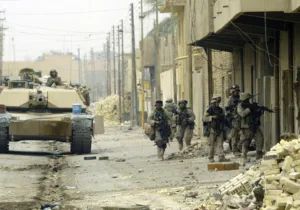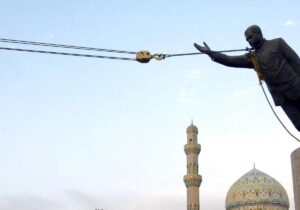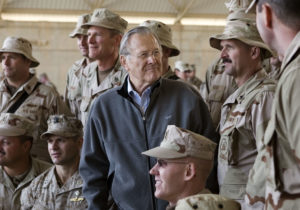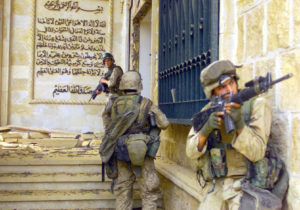Twenty years ago this week, U.S. Marines sweeping into Baghdad helped a throng of Iraqis tear down a massive statue of Saddam Hussein in Firdos Square. Rich in symbolism, the moment marked the end of Saddam’s terrorist tyranny—and underscored that the long suffering Iraqi people needed America’s help to bring about that objective.
From the safety and clarity of 2023, the reasons to criticize the war are obvious. This tendency to look back and learn lessons is one of the characteristics that makes America exceptional—and indeed strengthens America. Our capacity for self-criticism can lead us to self-correction. However, with many engaging not in healthy self-criticism, but rather in a kind of historical revisionism that borders on gaslighting—claims that Saddam Hussein’s Iraq was declawed and thus posed no threat; claims that Washington concocted WMDs as a pretext, bypassed the UN, went to war unilaterally, waged war without public support, turned Iraq into a failed state; claims that senior policymakers opposed what they supported—let’s focus for a moment on what Saddam Hussein’s Iraq was in 2003, what it represented in 2003, what it did in 2003, and what America did—and didn’t do—in 2003.
What Iraq was in 2003
First, with tentacles stretching to the 1993 World Trade Center bombers, Abu Musab Zarqawi and other al-Qaeda members, Abu Nidal, and Palestinian suicide bombers, Iraq was in 2003 a metastasis of terrorism. Congress cited “Iraq’s ongoing support for international terrorist groups” as a primary justification for war.
Second, Iraq in 2003 had a long track record of developing and using chemical weapons. Saddam Hussein unleashed chemical weapons against the Kurds in northern Iraq and against Iran. He never provided verifiable proof that he had dismantled his WMD program.
Third, Iraq in 2003 was a constant threat to regional security and U.S. interests. Saddam Hussein’s Iraq was a recidivist regime that made war against four of its neighbors; threatened vital global resources; and gamed the UN. From the safe distance of history—with all the unknowns now known—the Iraq of 2003 may look like a declawed animal in a “cage.” But in 2003, Iraq looked like a violent repeat offender plotting revenge and awaiting parole.
Fourth, Iraq in 2003 was unraveling. A quarter-century of misrule and international sanctions had grinded Iraq down to failed-state status. The late Fouad Ajami, whose words and wisdom we desperately miss in this debate over Iraq, noted that Iraq on the eve of war was “a country wrecked and poisoned.”
What Iraq Represented in 2003
The Bush administration made many mistakes in planning and prosecuting the war—and, some argue, in going to war. But it deserves credit for recognizing that 9/11 altered the very DNA of American national-security strategy; the cascading consequences of this were far reaching. As historian John Lewis Gaddis has written, “Any administration in such a crisis would have had to rethink what it thought it knew about security.” Was deterrence possible? Was containment viable? Was giving repeat offenders like Saddam Hussein the benefit of the doubt responsible? The Bush administration’s answer to each question was “no” and Congress concurred. Consider the transformation of Sen. John Kerry—anything but a hawk—who registered his support for the war in Iraq by declaring that Saddam’s “weapons of mass destruction…represent an unacceptable threat”; warning that Saddam might “reinvade Kuwait, push the Kurds out, attack Israel”; and asking, “In the wake of September 11…can we afford to ignore the possibility that Saddam Hussein might accidentally, as well as purposely, allow those weapons to slide off to one group or other?”
In short, Saddam Hussein’s behavior, associations and record fueled a presumption of guilt that, when mixed with America’s profound sense of vulnerability after 9/11, created a deadly combination. This is the most fundamental way 9/11 is linked to Saddam Hussein: The latter didn’t perpetrate the former, but the former served as a lesson about the danger of failing to confront threats before they are fully formed. In the same way, the appeasement of Hitler at once had nothing and yet everything to do with how America waged the Cold War with Moscow.
What Iraq did in 2003
In late 2002, the UN Security Council—in exquisitely UN fashion—approved a resolution requiring Iraq to comply with existing resolutions. Led by Hans Blix, UN weapons inspectors then returned to Iraq. What they found was troubling before the invasion and puzzling after the invasion.
Blix and his inspectors—not the White House or CIA—concluded that 10,000 liters of anthrax, 550 mustard-filled shells and 450 mustard-filled bombs were unaccounted for. The inspectors expressed “uncertainty”—variants of that word were used 33 times in the report—with respect of 6,526 chemical-tipped bombs and expressed a “strong presumption…that about 10,000 liters of anthrax was not destroyed and may still exist.”
Like a Rorschach test, the report looked different in different capitals: The French and Germans saw nothing in the report that proved the existence of those weapons. The Americans and British saw nothing in the report that disproved their existence—only confirmation of their deepest fears.
Blix’s conclusion in early 2003 fueled those fears: “Iraq appears not to have come to a genuine acceptance, not even today, of the disarmament which was demanded of it.”
Charles Duelfer, lead U.S. weapons inspector, added: “Saddam wanted to re-create Iraq’s WMD capability, which was essentially destroyed in 1991, after sanctions were removed.”
As long as Saddam was in power, Iraq wouldn’t come clean with the UN—and wouldn’t be viewed in Washington as anything but a threat.
What America Did in 2003
Contrary to Secretary of State Colin Powell’s “Pottery Barn Rule,” Iraq wasn’t broken because America intervened in 2003; America intervened in 2003 because Iraq was broken—its problems and pathologies oozing into the region and continually threatening U.S. interests.
Saddam Hussein invaded Iran and Kuwait; bombed Saudi Arabia and Israel; took out his post-Desert Storm vengeance on the Kurds; tried to assassinate a U.S president; harbored and funded terror groups; and continually gamed the UN Security Council, which, aside from Britain and America, had lost interest by 1998 in enforcing its own Iraq-related resolutions. The U.S. tried to contain Saddam by carrying out sporadic airstrikes, enforcing no-fly zones and even declaring “no-drive zones”—all to prevent Saddam from reconstituting his WMD program, threatening his neighbors and brutalizing his people. Indeed, it pays to recall that Saddam murdered 600,000 Iraqis. This mention of Saddam’s internal cruelties isn’t to suggest that Washington should dispatch U.S. troops to wage righteous humanitarian war here, there and everywhere—but rather to raise a question for the humanitarian hawks who understandably cheered U.S. humanitarian interventions in Somalia, Haiti, Bosnia, Kosovo, East Timor, Libya, ISIS-occupied Iraq and other friendless places: If it was justifiable to risk U.S. lives and expend U.S. treasure on humanitarian grounds in those places, why was it not in Saddam Hussein’s Iraq?
That’s a discussion for another essay. The purpose of this litany is to remind those with perfect 20/20 hindsight that Saddam Hussein was a problem no U.S policy approach—enemy-of-my-enemy realpolitik, UN sanctions, containment, UN inspections, police-action war, “low-grade war,” no-fly zones, whack-a-mole airstrikes—could solve. Without question, Operation Iraqi Freedom created many problems, but we must not forget that it removed the source of many problems: Saddam Hussein.
Nor should we forget that Operation Iraqi Freedom lived up to its name. Iraq is anything but perfect today. However, it is free—bloodied and scarred, to be sure, but free. The U.S.-led coalition liberated 24 million Iraqis. They are free from tyranny, free from Saddam’s omnipresent terrors, free from being required to pledge “our souls and our blood…for you, O Saddam.” Iraqis wrote a constitution in 2004; they held their first free election in 2005, when 75 percent of eligible voters marched, walked, limped to the polls to prove they belong in the democratic family. They held their sixth parliamentary elections in 2021.
Noting that “it’s much better to have freedom and democracy rather than a dictatorship,” Iraqi President Abdul Latif Rashid says Americans helped “save” Iraq. Adds former Iraqi Prime Minister Mustafa al-Kadhimi: “Iraqis recognize that the U.S. got rid of an evil dictator and helped build a democracy.” America’s military, in partnership with 37 other nations (another fact the revisionists must not be allowed to airbrush out of history), made this possible.
Nor should we forget—or allow the revisionists to spin alternate histories about—what the public thought of the war in 2003. The Bush administration may have gone to war too hastily, resourced the postwar occupation too thinly and set objectives that were too ambitious (“ending tyranny in our world”). But the administration didn’t drag an uncertain public or ambivalent Congress into war. Polls showed 69-percent support for the war in early 2003. Unlike administrations that bookended it (Reagan in Grenada, Bush 41 in Panama and Somalia, Clinton in Kosovo, Obama in Libya), the Bush 43 administration sought and received congressional authorization before sending American troops to war. The Iraq War resolution passed the Senate 77-23 and the House 296-133. Moreover, as early as 1998, Congress was on record supporting “efforts to remove the regime headed by Saddam Hussein…and to promote the emergence of a democratic government to replace that regime.”
What America Didn’t Do in 2003
America didn’t go to war based on a lie. As Judge Laurence Silberman, former chairman of a bipartisan commission on prewar intelligence, explains: “The intelligence community’s 2002 National Intelligence Estimate (NIE) stated in a formal presentation to President Bush and to Congress its view that Saddam had weapons of mass destruction…Presidential daily briefs dating back to the Clinton administration were, if anything, more alarmist about Iraq’s WMD than the 2002 NIE…It is one thing to assert, then or now, that the Iraq War was ill-advised. It is quite another to make the horrendous charge that President Bush lied to or deceived the American people about the threat from Saddam.”
It was Saddam—in a fateful, fatal gamble—who lied and deceived. As a group of military analysts detailed in a seminal postwar postmortem, “When it came to weapons of mass destruction, Saddam attempted to convince one audience that they were gone, while simultaneously convincing another that Iraq still had them.” They noted that Saddam maintained “the illusion of having WMDs” and that “many within Iraq’s ruling circle never stopped believing that the weapons existed.”
If Saddam’s inner circle believed he had WMDs, why would—how could—the Bush administration believe otherwise?
Reasonable people can disagree about the prelude to, and prosecution of, the war. There are valid reasons to criticize this chapter in our history—the swaggering hubris, the shortsighted planning, the blind spot about Iran, the wishful thinking about a democratic domino effect. What’s not reasonable is airbrushing what was known and not known about Iraq in 2003—or retroactively projecting what is known today onto 2003.
What Iraq Did to America
Just as Pearl Harbor shattered America’s pre-World War II consensus in favor of isolationism, Iraq shattered America’s post-World War II consensus in favor of engagement.
We see this in polling: Today, 51 percent of Americans say the U.S. “should pay less attention to problems overseas and concentrate on problems at home,” up from 30 percent before the war. We see this in election results: In 2008, 2012 and 2016, Americans elected candidates who advocated and implemented policies of disengagement; today, there are growing blocs in the party of Eisenhower and Reagan, and the party of Truman and Kennedy, that want to retreat and retrench. Finally, we see this in the surprising consonance of politicians as dissimilar as President Barack Obama and President Donald Trump, Sen. Bernie Sanders and Sen. Rand Paul.
A more somber aspect of Iraq is its toll on America’s military. Between 2003 and 2011, Iraq claimed 4,505 U.S. troops and DoD civilian personnel. Another 32,392 were wounded—many of them bearing the deep scars of polytrauma, all of them bearing deeper scars to soul and memory.
Was Iraq’s liberation worth these costs? The deaths and scars—physical and invisible—are not easily justified in the long shadows cast at Firdos Square. Of course, the sacrifice of a person in the prime of life is never easily justified. Nor should it be. What seems justifiable in the abstract, through the filter of news reports and history books, seldom does when it’s personal. Each of those deaths represents a life unfinished, a future unfulfilled, a family haunted by constant reminders of loss—the undented pillow, the uncelebrated birthday, the unspoken “I love you.”
War is not a matter of sterile statistics, but of human beings—Americans and Iraqis, soldiers and civilians—fearfully and wonderfully made in God’s image, knitted together by a Creator who never intended for His greatest creation to be maimed or killed. Yet in a broken world full of broken nations led by broken men, war will continue to be a curse for humanity, a heavy burden for those who wage it and survive it, and a source of harsh debates and hard lessons for free nations.
The debates are necessary—but to learn the right lessons, those debates cannot be defined by revisionist hindsight.







 Live in the DC area? Sign-up for Providence's in-person events list!
Live in the DC area? Sign-up for Providence's in-person events list!